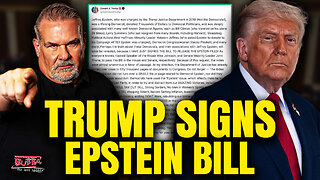Premium Only Content

Roger's Realtime Talkshow Event
Episode 18 (Review)
1. Anarcho-Syndicalist Movement believes in; revolutionary industrial unionism or syndicalism as a method for workers in a capitalist society to gain control of an economy and thus control influence in a broader society.
Note: The goal of syndicalism is to abolish the wage system, regarding it as wage slavery, and Anarcho-syndicalist theory generally focuses on the labour movement.
2. The labour movement is the collective organisation of working people to further their shared political and economic interests.
a. It consists of the trade union or labour union movement, as well as politcal parties of labour. It can be consider an instance of class conflict.
b. Class Conflict in the political and economic philosophies of Karl Marx and Mikhail Baunin, is a central tenet and practical means of effecting radical sociolpolitical changes for the social majority, the working class.
*It's the central concept within conflict theories of sociology and political philosophy.
3. Despite the weakness of its adult organisation, the SDF was instrumental in the development of the movement of Socialist Sunday Schools for children, institutions which taught socialist ideas and ethical principles to youngsters in competition with various denominations' Sunday schools.
a. *During this interval the SDF experienced the atrophy of its ultra-parliamentary right wing to the Independent Labour Party (ILP). This party, led by Keir Hardie, was a big tent party of the left, more heavily influenced by Christian Socialism than by the atheistic Marxism of the SDF.
4. The British Socialist Party (BSP) was a Marxist political organisation established in Great Britain in 1911. Following a protracted period of factional struggle, in 1916 the party's anti-war forces gained decisive control of the party and saw the defection of its pro-war right wing. After the victory of the Bolshevik Revolution in Russia at the end of 1917 and the termination of the First World War the following year, the BSP emerged as an explicitly revolutionary socialist organisation. It negotiated with other radical groups in an effort to establish a unified communist organisation, an effort which culminated in August 1920 with the establishment of the Communist Party of Great Britain. The youth organisation the Young Socialist League was affiliated with the party.
2. Of these eight policies, the living wage, the unemployment allowance, nationalisation of banking and the bulk purchase of raw materials and foodstuffs were the chief concern of the ILP.
a. The centerpiece of the ILP program was the "Living Wage" policy, which sought to impose high minimum wages across all industries and nationalize all private enterprises which could not afford to pay them in order to resolve interwar unemployment and poverty, which it held to be caused by underconsumption.
b. Increasing the unemployment allowance and switching to bulk purchasing were to be done in the conventional way, but the method of paying the living wage differed from Labour practices. The ILP criticised the "Continental" method of paying wage allowances from employers' pools, which had been implemented in 1924 by Rhys Davies. The ILP proposed to redistribute the national income, meeting the cost of the allowances by taxing high income earners.
c. The nationalisation of banking involved more significant changes to economic policy, and had nothing in common with Labour practices. The ILP proposed that once a Labour government took office it should hold an enquiry into the banking system that would prepare a detailed scheme for transferring the Bank of England to public control, revise the operation of the Bank Acts and ensure that "control of credit is exercised in the national interest and not in the interest of powerful financial groups" by making creditors shift entirely to cheques and possibly getting rid of gold reserves, thus ending the policy of deflation practised by the Treasury and the Bank of England.
-
 15:00
15:00
The Praetorian
17 days agoUntethered
6 -
 DVR
DVR
Chad Prather
15 hours agoStanding Firm When the World Says Sit Down
61.2K41 -
 LIVE
LIVE
LFA TV
12 hours agoLIVE & BREAKING NEWS! | THURSDAY 11/20/25
2,820 watching -
 LIVE
LIVE
AP4Liberty
11 hours agoTrump–Musk Alliance 2.0: What Their Sudden Reconciliation Means for America’s Future
353 watching -
 22:20
22:20
World2Briggs
18 hours ago $10.90 earnedEveryone Is Leaving These 15 States. Truth Behind the Trend.
22.1K15 -
 4:24
4:24
Gamazda
19 hours ago $4.84 earnedDeep Purple – Smoke On the Water (Live Piano Cover in a Church)
12.9K14 -
 12:54
12:54
Brad Owen Poker
14 hours ago $1.79 earnedI Make Final Table! I’m Going To $10,400 WPT World Championship!!
22.6K1 -
 10:00
10:00
TheMightyMcClures
22 days ago $1.31 earnedWe Fed 500 Families!
12.3K4 -
 6:23
6:23
The Shannon Joy Show
14 hours agoWas Covid a MILITARY OPERATION?
11.9K8 -
 LIVE
LIVE
The Bubba Army
23 hours agoTRUMP SIGNS EPSTEIN BILL! - Bubba the Love Sponge® Show | 11/20/25
1,457 watching